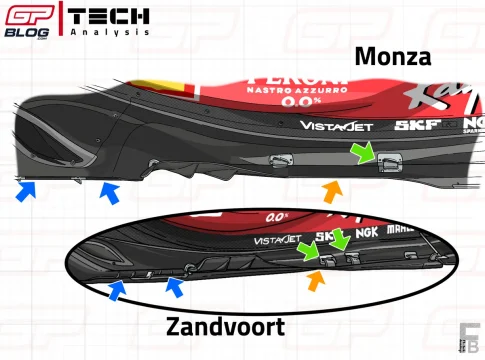Ferrari’s recent victory at Monza might have fooled fans into thinking it was all about the track and strategy. But the Azerbaijan Grand Prix showed a different story, with Ferrari’s SF-24 performing well in both qualifying and the race, finishing just behind Piastri’s MCL38.
The upgrades introduced at Monza seem to have made the car more balanced, and the performance in Baku confirms this progress.
“Old Solutions” for New Gains
At Monza, Fred Vasseur’s team brought a significant package focusing on the car’s floor. The floor is modular, meaning it has parts that can be swapped out without replacing the entire floor, saving costs. Ferrari introduced a new floor with changes to various modules, including the sidepod and mirror support.
The outermost floor fences were reshaped for better connection, and the mirror support was made smaller and thicker. The floor shape around the lower SIS was also modified to improve airflow to the rear diffuser and beam wing.
Both components were revised further. The sidepod’s lower portion was excavated more to increase air channeling towards the car’s rear end. The floor edge now has a flatter shape and a central cut to maintain vortex structures that seal off the bottom. New metal supports were added to manage flexing during fast corners.
A new diffuser was also introduced at Monza, featuring an almost pointed tail end of the boat section with a higher starting keel compared to its predecessor.
Ferrari revisited some older solutions to address issues faced with their Spanish Grand Prix package. These changes aimed to reduce porpoising by simplifying designs that stabilize downforce generation.
A More Stable SF-24
The hard work paid off as the SF-24 showed improved behavior on track since these upgrades. It performed well on straights, slow corners, and fast corners (though still slightly behind McLaren). Leclerc confirmed this after qualifying in Baku: “The car felt really good since FP1… Straight away, I felt happy and the balance remained really good.”
Fans might think this is a sign of Ferrari finally turning things around.
The SF-24 displayed excellent aerodynamic compromise and mechanical setup, providing stability at low speeds and good top speed despite being slower than McLaren’s MCL38. This setup helped in tire management, allowing Leclerc to open a gap during his first stint on mediums and aiding Sainz’s comeback in the final laps.
This improvement in tire management shows that Ferrari’s new package works well across different track layouts. The consistent downforce helps put tires into their optimal working window, leading to stable performance throughout stints.
Leclerc highlighted this progress: “On the other hand it’s been pretty good the last couple of races in terms of performance… within the team we are in a good mood and we need to keep pushing in that direction.”
Looking Forward: Singapore & Austin
Fred Vasseur is optimistic about Singapore due to its slow corners and chicanes suiting the SF-24: “But in these last two races plus Singapore, we need to maximize points and take opportunities if we have opportunity to actually win races.”
However, he believes true evaluation will come at Austin: “So we’ve got to wait maybe for Austin…to understand whether we’ve done the steps forward we expected.”
Austin’s varied corners will be a perfect test for SF-24’s updates. Only then will we know how Ferrari stacks up against McLaren and Red Bull in terms of pure pace. Until then, Ferrari needs to maximize points scored.
What do you think? Can Ferrari keep up this momentum?

